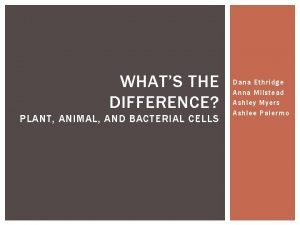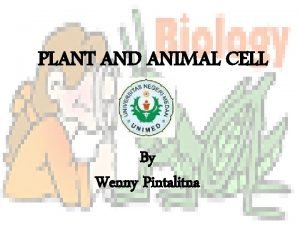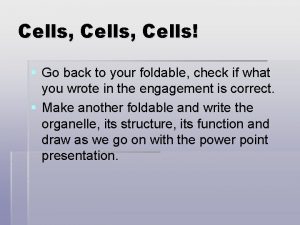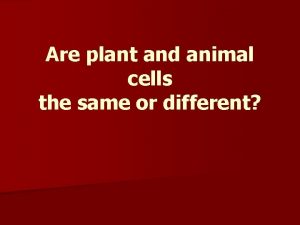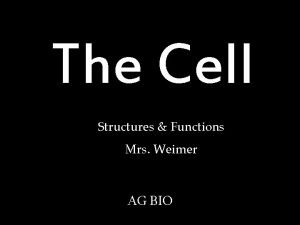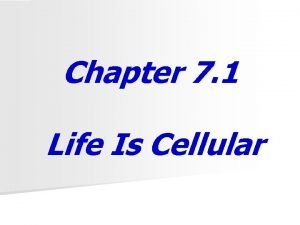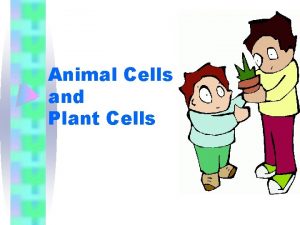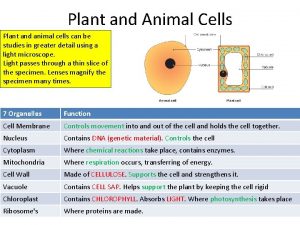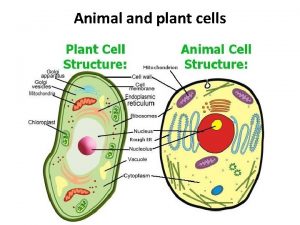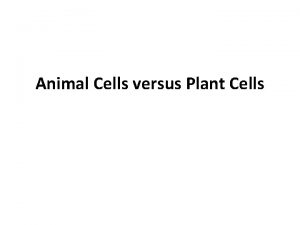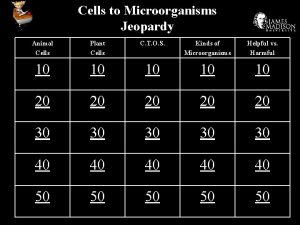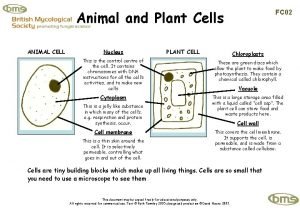Plant and Animal Cells How are plant and














- Slides: 14

Plant and Animal Cells How are plant and animal cells the same, and how are they different?

Plant and Animal Cells �“Because there are so many different kinds of organisms, there must be at least as many different kinds of cells. ” �Do you agree with this hypothesis?

Plant and Animal Cells �Surprisingly there are more similarities than differences among cells. �The cells of all plants and the cells of all animals have many structures in common. �Using a microscope, it is quite easy to tell plant cells from animal cells. However, it is difficult to tell which plant cell came from which plant, and which animal cell came from which animal.

Plant and Animal Cells Cell Parts Animal Cell cell ✔ membrane nucleus ✔ vacuoles ✔ chromosome ✔ s cell wall ✗ chloroplasts ✗ Plant Cell ✔ ✔ ✔

Animal Cell


The Nucleus (Control) �The nucleus is the “brain” or the control centre of a cell. �It controls or directs all of the cell’s activities. �A nuclear membrane surrounds the

Chromosomes (Control) �Chromosomes are rodlike structures found inside the nucleus. �They carry information the cell needs to function. �Chromosomes contain genetic information about a cell. �A parent passes genetic information to its offspring.

Cell Membrane (Materials) �The cell membrane is like a cover that surrounds the cell. �It acts like a gate keeper. �Food moves into the cell through the cell membrane and waste moves out of the cell through the cell membrane.

Cytoplasm (Materials) �Most of the cell is cytoplasm, a watery fluid. �The cytoplasm allows materials to be transported quickly between structures in the cell. �The cytoplasm also stores waste until it can be disposed of.

Vacuole (Materials Storage) �Each vacuole is filled with fluid. �A vacuole is used to store water, and nutrients, such as sugar and minerals. �Vacuoles also hold waste until it can leave the cell. �Plant cells have much larger vacuoles than animal cells.

Cell Wall (Protection) �The cell wall is only found in plant cells. �It protects and supports the plant cell. �The cell wall is made of cellulose. People use cellulose for different things. (Paper is made from the cellulose in trees. ) �The cell wall allows materials to pass into the cell through pores, or small holes, in the cell wall.

Chloroplasts (Food Production) �Chloroplasts are only found in plant cells. �Chloroplasts contain many molecules of a green chemical called chlorophyll. �Chlorophyll allows plant cells to make their own food, using light from the sun (photosynthesis).

Cell Structures for Movement �Some cells are able to move on their own. These cells have extra features that are not found on other cells. �Flagellum: �The flagellum is a whip like tail that helps some cells move. �They whip their tail back and forth to move. �Cilia: �Cilia are tiny hairs on the outside of a cell. �These tiny hairs work together to move a cell or move the environment surrounding the cell.
 Similarities between plant and animal cells venn diagram
Similarities between plant and animal cells venn diagram Mikael ferm
Mikael ferm Difference between bacteria and plant cell
Difference between bacteria and plant cell Venn diagram plant cell and animal cell
Venn diagram plant cell and animal cell Cloroplasto
Cloroplasto Plant cell vs animal cell
Plant cell vs animal cell Paragraph on animal cell
Paragraph on animal cell Simple vs complex carbs
Simple vs complex carbs Plant and animal cells
Plant and animal cells Plant and animal cell foldable
Plant and animal cell foldable Whats the difference between plant and animal cells
Whats the difference between plant and animal cells Different parts of the animal cell
Different parts of the animal cell Whats the difference between plant and animal cells
Whats the difference between plant and animal cells Cpalms investigating plant and animal cells
Cpalms investigating plant and animal cells Chapter 7-1 life is cellular answer key
Chapter 7-1 life is cellular answer key


